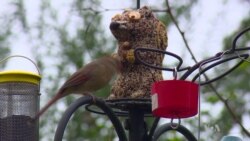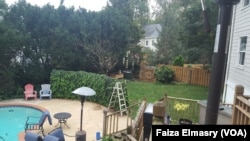Fifty-three million Americans feed the birds. One of them is Arlington, Virginia, resident Sumner Askin. He got interested in feeding them a few years ago, when he was in college majoring in wildlife science.
“I had just taken this class, ornithology, the study of birds, and I just got into it,” he recalls. “I originally got one feeder, and I put it all the way up on this tree by climbing like 30 feet and hung it right outside my window. I’d seen cool stuff and I just wanted to keep going, see what else I could get.”
What he got was lots of birds: downy woodpeckers, northern cardinals, mourning doves, house sparrows, hummingbirds and many others.
Watch and learn
Askin says watching birds is a learning experience.
“You learn just how each species is designed differently, like the way their toes are shaped so they grab things differently and climb,” he said. “You see the individuality of each of them. Like a lot of the invasive species around here like the house sparrow and European starling, you have a little disdain for them. They chase around other guys. Some people don’t like the big blue jays because they’re loud. But I like them a lot. They are just big.”
Askin uses a variety of feeders to make it more adventurous for the birds.
“Most birds like a small sparrow can’t exactly stand on the side of a tree like a woodpecker can, because (the woodpecker) gets its toes in there and just climbs up. The low-hanging feeder over there, a normal feeder, they sit on it and they turn sideways and they eat, but that one, they have to hang upside-down. So you watch them just pivot completely upside down. And only two species can do that. So it’s just for them instead of the non-native sparrows.”
Why feed birds?
Askin works part time at Wild Birds Unlimited, a store that sells seed, feeders and other necessities for backyard birders.
Michael Zuiker has run this business for 26 years. He says feeding birds is a win-win proposition. Birders enjoy watching the birds, and the birds — native ones and those just migrating through — get some needed sustenance to survive in the growing urban sprawl. He’s not surprised the hobby is so popular.
“Gardening is the first, backyard bird feeding second. They pretty much blend into each other. We spend a lot of time also with schools. A lot of school teachers now have programs and they set habitats in their schools to teach the young kids about the birds, the species, the nesting and how to track them.”
Zuiker says people like to feed and watch wild birds for many reasons.
“I think one of the most important reasons is that it’s a very, very peaceful emotional experience. You put the food out there, you spend time on your deck in the nice weather, in winter you’re indoors watching birds. And you never know what’s going to show up. Most of the yards around can easily get 30 different species of the birds in their backyards.”
Birds for relaxation and company
Paul Starzynski picked up bird feeding as a hobby after he retired three years ago.
“If you sit quietly, they come real close and you don’t bother them; you can watch them. You can even see the little seed in their beak before they swallow it. It’s kind of fun. Besides, I like them flying over my head. I would be alone out there if I didn’t have the birds.”
Other birders take the hobby to another level.
“My neighbor is a real birder,” Starzynski said. “He knows everything. I don’t. He found 13 species by lunch in his backyard. Some of them just look the same to me, but he knows the difference between that one and that one.”
Even without knowing the bird species or where they come from, Starzynski loves his new hobby. He’s just one of millions of Americans who enjoy the colorful beauty and songs feathered visitors bring to their backyards.












